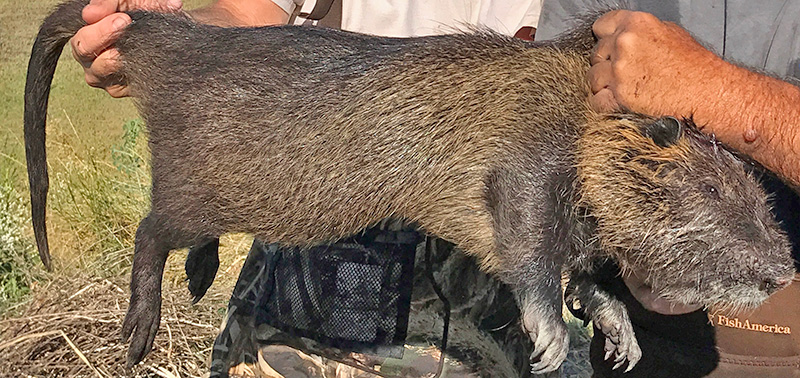And I Thought Gophers and Squirrels Were Bad
Dang, that’s a big “gopher”. Gophers have been the bane of my yard for 25 years.
I once pondered whether beaver should be removed as beaver too are an invasive species, but I have mixed feelings there, as they have some benefits and are not even in the same category of destruction. Nutria need to be exterminated as quickly as possible in California.
Discovery of invasive nutria in California
But the Nutria (Myocastor coypus) is a serious threat to humans in several ways as well as to the environment in general.
Nutria cause various kinds of damage through burrowing, intense herbivory, and carrying pathogens and parasites. Nutria do not construct dens, they burrow, frequently causing water-retention or flood control levees to breech, weakening structural foundations, and eroding banks. They can consume up to 25% of their body weight in above- and below-ground vegetation each day, but they waste and destroy up to 10 times as much, causing extensive damage to the native plant community and soil structure, as well as significant losses to nearby agricultural crops.
The loss of plant cover and soil organic matter (roots, rhizomes, tubers) results in severe erosion of soils, in some cases destroying marshlands and leaving behind open water. The destructive feeding habits of nutria threaten populations of rare, threatened, or endangered species that rely on critical wetland habitats.
Nutria also serve as hosts for tuberculosis and septicemia, which are threats to humans, livestock, and pets. Additionally, nutria carry tapeworms, a nematode that causes a rash known as “nutria itch”, and nutria carry blood and liver flukes, which can contaminate swimming areas and drinking water supplies.
...
CDFW has deployed nutria survey teams from the Delta through the San Joaquin Valley. CDFW needs written access permissions to enter or cross private properties for the purposes of conducting nutria surveys and, where detected, implementing trapping efforts. Landowners and tenants, we need your help; so CDFW can survey for and remove destructive nutria from your properties, complete and submit the Nutria Project Temporary Entry Permit.
See Mark’s comment further below. There appears to be no particular reason to be concerned about disease vectors as compared to plenty of other animals.


Mark C, wildlife biologist, writes:
Regarding nutria: while I agree they are potentially a very serious problem (mainly from agricultural damage and burrowing), and they should be eliminated from California as fast as we can (if possible), there’s no need to get one’s knickers too much into a knot over disease issues:
Sounds scary but the same is true for most native mammals (possibly other than the ‘nutria itch’ parasite, which sounds fairly host-specific). For example, cows used to be an important vector for tuberculosis (one of the many reasons most milk is pasteurized). Anything that bites you — dogs, cats, humans, whatever — may potentially cause septicemia. So can simple scratches from inanimate objects. So can infection by other routes. Most (all?) wild mammals can carry tapeworms (most of which, most of the time, don’t cause major problems). Blood and liver flukes are also common in wild and domestic animals (e.g, in deer, goats, sheep: https://en.wikipedia.org/wiki/Fascioloides_magna, https://en.wikipedia.org/wiki/Fasciolosis). Raccoons carry a nematode that is often lethal if it infects humans (https://en.wikipedia.org/wiki/Baylisascaris_procyonis ).
Common-sense standard hygiene measures will prevent almost all such infections: don’t eat undercooked wild game (especially if it hasn’t been deep-frozen first), don’t get bitten or scratched (avoid unnecessary contact), wash hands thoroughly after any contact (or wear protective gloves), boil water collected from ‘wild’ sources before consumption, etc.
Interestingly, trematodes (‘flukes’) always have a mollusk as an intermediate host — usually a snail, often in freshwater. There may be several intermediate hosts before the parasite reaches the ‘final’ host, but as far as I know, all have to ‘use’ a mollusk as part of their life cycle.
You may have seen this Oatmeal cartoon: https://theoatmeal.com/comics/captain_higginshttps://theoatmeal.com/comics/captain_higgins
...
DIGLLOYD: I guess I got lucky all those years of skinning the squirrels I shot. But that rabbit with the huge fluke or whatever it was made it the last rabbit I ever (didn’t eat).
That oatmeal cartoon is indeed hilarious. Seems like a great way to educate and laugh at the same time.
Although the typical response is disgust, most biologists think parasites are fascinating. Their life cycles are often amazingly complex. They and their hosts have co-evolved probably since the first plants and animals, and their effects on essentially all aspects of biology are only beginning to be understood.
Every human on the planet has lots of non-human cells living on or in them — mostly bacteria. The common assumption is that there are about 10 times as many bacterial cells in a person as their own cells (mostly in the large intestine). Many (most) of us have microscopic mites living on our faces: https://www.bbc.com/earth/story/20150508-these-mites-live-on-your-facehttps://www.bbc.com/earth/story/20150508-these-mites-live-on-your-face
A few brief examples taken from my introductory biology lectures (sorry for the large attachment; it’s due to the images) [diglloyd: not included here].
There’s a video of Leucochloridium that’s worth watching here: https://en.wikipedia.org/wiki/Leucochloridium_paradoxum If you really want to be revolted, go here: https://en.wikipedia.org/wiki/Wuchereria_bancrofti
DIGLLOYD: that’s mitey disgusting!























